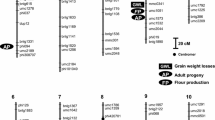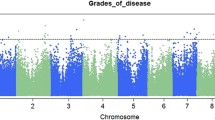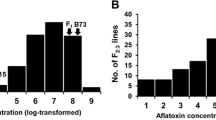Abstract
Aflatoxin is a mycotoxin produced by the fungus Aspergillus flavus (Link:Fr), an opportunistic ear-rot pathogen of maize (Zea mays L. ssp. mays). Pre-harvest contamination of maize grain with aflatoxin is a chronic problem worldwide and particularly in the Southeastern US. Quantitative trait loci (QTL) were mapped by multiple interval mapping (MIM) in a population consisting of 250 F2:3 lines derived from the cross Mp715 × Va35. Mp715 is resistant to the accumulation of aflatoxin and Va35 is susceptible. The population was genotyped with 1200 single-nucleotide polymorphism (SNP) and simple sequence repeat (SSR) molecular markers and phenotyped for the accumulation of total aflatoxins under artificial inoculation in four environments. Both parents contributed resistance alleles. Two QTL in bins 6.06 and 7.03 were the most promising for the marker-assisted introgression of the resistance present in Mp715. They were the most consistent across individual environments and together were responsible for nearly 30% of the phenotypic variance when data was combined across all four environments. In addition to those two QTL, Mp715 was also the source of the beneficial aflatoxin-reducing allele for several smaller effect QTL. Once their effect is validated in further experiments, the identification of these relatively large effect QTL should facilitate the utilization of this aflatoxin accumulation-resistant germplasm in applied maize breeding programs.
Similar content being viewed by others
References
Abbas HK, Williams WP, Windham GL, Pringle HC, Xie W, Shier WT (2002) Aflatoxin and fumonisin contamination of commercial corn (Zea mays) hybrids in Mississippi. J Agric Food Chem 50:5246–5254
Abbas HK, Cartwright RD, Xie W, Shier WT (2006) Aflatoxin and fumonisin contamination of corn (maize, Zea mays) hybrids in Arkansas. Crop Prot 25:1–9
Alwala S, Kimbeng CA, Williams WP, Kang MS (2008) Molecular markers associated with resistance to Aspergillus flavus in maize grain: QTL and discriminant analyses. J New Seeds 9:1–18
Andorf CM, Cannon EK, Portwood JL, Gardiner JM, Harper LC, Schaeffer ML, Braun BL, Campbell DA, Vinnakota AG, Sribalusu VV, Huerta M, Cho KT, Wimalanathan K, Richter JD, Mauch ED, Rao BS, Birkett SM, Sen TZ, Lawrence-Dill CJ (2015) MaizeGDB update: new tools, data and interface for the maize model organism database. Nucleic Acids Res 44:1195–1201
Beavis WD (1994) The power and deceit of QTL experiments: lessons from comparative QTL studies. In: 49th Annual Corn and Sorghum Industry Research Conference. ASTA, Washington, DC, pp 250–266
Bennett JW, Klich M (2003) Mycotoxins. Clin Microbiol Rev 16:497–516
Bennett JW, Kale S, and Yu J. 2007. Aflatoxins: background, toxicology, and molecular biology. In: Simjee S (ed.) Foodborne diseases. Humana Press. p355–373
Betran FJ, Mayfield K, Isakeit T, Menz M (2006) Breeding maize exotic germplasm. In: Lamkey KR, Lee M (eds) Plant breeding: the Arnel R. Hallauer international symposium. Blackwell Publishing, Ames, IA, pp 352–367
Brooks TD, Williams WP, Windham GL, Willcox MC, Abbas HK (2005) Quantitative trait loci contributing resistance to aflatoxin accumulation in maize inbred Mp313E. Crop Sci 45:171–174
Brown RL, Bhatnagar D, Cleveland TE, Chen ZY, and Menkir A. 2013. Development of maize host resistance to aflatoxigenic fungi. In: M. Razzaghi-Abyane, editor, Aflatoxins: recent advances and future prospects. InTech. p. 3-23
Bruns HA (2003) Controlling aflatoxin and fumonisin in maize by crop management. J Toxicol 22:153–173
Busboom KN, White DG (2004) Inheritance of resistance to aflatoxin production and Aspergillus ear rot of corn from the cross of inbreds B73 and Oh516. Phytopathology 94:1107–1115
CAST. 2003. Mycotoxins: risks in plant, animal, and human systems. CAST Task Force Rep. 139. Counc. Agric. Sci. Technol., Ames, IA
Churchill GA, Doerge RW (1994) Empirical threshold values for quantitative trait mapping. Genetics 138:963–971
Clements MJ, White DG (2004) Identifying sources of resistance to aflatoxin and fumonisin contamination in corn grain. J Toxicol 23:381–396
Cotty PJ (2006) Biocompetitive exclusion of toxigenic fungi. In: Barug D et al (eds) The mycotoxin factbook. Wageningen Academic Publ., Wageningen, Netherlands, pp 179–197
Daves C, Windham GL, and Williams WP. 2010. Aflatoxin accumulation in commercial corn hybrids artificially inoculated with Aspergillus flavus in 2008 and 2009. Res. Rep. 24(9). MS Agric. For. Exp. Stn., Mississippi State, MS.
Dhakal R, Windham GL, Williams WP, Subudhi PS (2016) Quantitative trait loci for reducing aflatoxin accumulation in corn. Mol Breed 36:164
Doerge RW, Churchill GA (1996) Permutation tests for multiple loci affecting a quantitative character. Genetics 142:285–294
Dorner JW (2010) Efficacy of a biopesticide for control of aflatoxins in corn. J Food Prot 73:495–499
Edwards MD (1992) Use of molecular markers in the evaluation and introgression of genetic diversity for quantitative traits. Field Crop Res 29:241–260
van Egmond HP, Jonker MA (2004) Worldwide regulations on aflatoxin: the situation in 2002. Toxin Rev 23:273–293
van Egmond HP, Schothorst RC, Jonker MA (2007) Regulations relating to mycotoxins in food – perspectives in a global and European context. Anal Bioannal Chem 389:147–157
FAO, 2004. Worldwide regulations for mycotoxins in food and feed in 2003. FAO Food and Nutrition Paper 81. Food and Agric. Organ. of the United Nations, Rome, Italy
Farfan IDB, de la Fuente GD, Murray SC, Isakeit T, Huang PC, Warburton M, Williams P, Windham GL, Kolometis M (2015) Genome wide association study for drought, aflatoxin resistance, and important agronomic traits of maize hybrids in the sub-tropics. PLoS One 10:e0117737. https://doi.org/10.1371/journal.pone.0117737
Frisvad JC, Skoube R, Samson RA (2005) Taxonomic comparison of three different groups of aflatoxin producers and a new efficient producer of aflatoxin B1, sterigmatocystin, and 3-O-methylsterigmatocystin Aspergillus rambelli sp nov. Syst Appl Microbiol 28:442–453
Gerdes JT, Behr CF, Coors JG, Tracy WF (1993) Compilation of North American maize breeding germplasm. CSSA, Madison, WI
Goodman MM (1999) Broadening the genetic diversity in maize breeding by use of exotic germplasm. In: Coors JG, Pandey S (eds) The genetics and exploitation of heterosis in crops. ASA, CSSA, and SSSA, Madison, WI, pp 139–148
Guo BZ, Widstrom NW, Lee RD, Coy AE, Lynch RE (2007) Registration of maize germplasm GT601 (AM-1) and GT602 (AM-2). J Plant Reg 1:153–154
Guo BZ, Krakowsky MD, Ni X, Scully BT, Lee RD, Coy AE, Widstrom NW (2011) Registration of maize inbred line GT603. J Plant Reg 5:211–214
Hallauer AR (1978) Potential of exotic germplasm for maize improvement. In: Walden DB (ed) Maize breeding and genetics. John Wiley & Sons, New York, NY, pp 229–247
Holland JB, Goodman MM (1996) Combining ability of tropical maize accessions with U.S. germplasm. Crop Sci 35:767–773
Holland JB, Nyquist WE, Cervantes-Martinez CT (2003) Estimating and interpreting heritability for plant breeding: an update. Plant Breed Rev 22:9–112
IARC, 2012. Aflatoxins. IARC monographs on the evaluation of carcinogenic risks to humans: a review of human carcinogens, Vol. 100F, Chemical agents and related occupations. Int. Agency for Res. on Cancer. Lyon, France. p. 225–248
Isik F, Holland JB, Maltecca C (2017) Genetic data analysis for plant and animal breeding. Springer, New York
Jansen RC (1993) Interval mapping of multiple quantitative trait loci. Genetics 135:205–211
Jansen RC 2007. Quantitative trait loci in inbred lines. In: D.J. Balding et al., editors, Handbook of statistical genetics, vol. 2. 3rd ed. John Wiley & Sons, West Sussex, England. p. 589–622
Jansen RC, Stam P (1994) High resolution of quantitative traits into multiple loci via interval mapping. Genetics 136:1447–1455
Jansen RC, de Jong AG, van Ooijen JW (2001) Constructing dense genetic linkage maps. Theor Appl Genet 102:1113–1122
Jones E, Chu WC, Ayele M, Ho J, Bruggeman E, Yourstone K, Rafalski A, Smith OS, McMullen MD, Bezawada C, Warren J, Babayev J, Basu S, Smith S (2009) Development of single nucleotide polymorphism (SNP) markers for use in commercial maize (Zea mays L.) germplasm. Mol. Breeding 24:165–176
Kao CH, Zeng ZB (2002) Modeling epistasis of quantitative trait loci using Cockerham’s model. Genetics 160:1243–1261
Kao CH, Zeng ZB, Teasdale RD (1999) Multiple interval mapping for quantitative trait loci. Genetics 152:1203–1216
Kew MC (2013) Aflatoxin as a cause of hepatocellular carcinoma. J Gastrointestin Liver Dis 22:305–310
Klich M (2007) Aspergillus flavus: the major producer of aflatoxin. Mol Plant Pathol 8:713–722
Llorente CF, Betran FJ, Bockholt A, Fojt F (2004) Registration of Tx772 maize. Crop Sci 44:1036–1037
Lu H, Romero-Severson J, Bernardo R (2002) Chromosomal regions associated with segregation distortion in maize. Theor Appl Genet 105:622–628
Mayfield KL, Murray SC, Rooney WL, Isakeit T, Odvody GA (2011) Confirmation of QTL reducing aflatoxin in maize testcrosses. Crop Sci 51:2489–2498
Mayfield KL, Betran FJ, Isakeit T, Odvody G, Murray SC, Rooney WL, Landivar JC (2012) Registration of maize germplasm lines Tx736, Tx739, and Tx740 for reducing preharvest aflatoxin accumulation. J Plant Reg 6:88–94
McMillian WW, Widstrom NW, Wilson DM (1993) Registration of GT-MAS:gk maize germplasm. Crop Sci 33:882
Menkir A, Brown RL, Bandyopadhyay R, Cleveland TE (2008) Registration of six tropical maize germplasm lines with resistance to aflatoxin contamination. J Plant Reg 2:246–250
Mideros SX, Warburton ML, Jamann TM, Windham GL, Williams WP, Nelson RJ (2014) Quantitative trait loci influencing mycotoxin contamination of maize: analysis by linkage mapping, characterization of near-isogenic lines, and meta-analysis. Crop Sci 54:127–142
Moreno OJ, Kang MS (1999) Aflatoxins in maize: the problem and genetic solutions. Plant Breed 118:1–16
Murray MG, Thompson W (1980) Rapid isolation of high molecular weight plant DNA. Nucleic Acids Res 8(19):4321–4326
van Ooijen JW (2006) JoinMap 4, software for the calculation of genetic linkage maps in experimental populations. Kyazma BV, Wageningen, Netherlands
Park DL, Liang B (1993) Perspectives on aflatoxin control for human food and animal feed. Trends Food Sci Technol 4:334–342
Paul C, Naidoo G, Forbes A, Mikkilineni V, White DG, Rocheford T (2003) Quantitative trait loci for low aflatoxin production in two related maize populations. Theor Appl Genet 107:263–270
Payne GA (1992) Aflatoxin in maize. Crit Rev Plant Sci 10:423–440
Payne GA (2016) Aflatoxins and aflatoxicosis. In: Munkvold GP, White DG (eds) Compendium of corn diseases, 4th edn. APS Press, St. Paul, MN, Am. Phytopathol. Soc., pp 97–98
Payne GA, Yu J (2010) Ecology, development, and gene regulation in Apsergillus flavus. In: Machida M, Gomi K (eds) Aspergillus: molecular biology and genomics. Caister Academic Press, Norfolk, UK, pp 151–171
Reddy KRN, Salleh B, Abbas HK, Abel CA, Shier WT (2010) An overview of mycotoxin contamination in foods and its implications for human health. Toxin Rev 29:3–26
Robens J, Cardwell K (2003) The costs of mycotoxin management to the USA: management of aflatoxins in the United States. Toxin Rev 22:139–152
Robertson-Hoyt LA, Jines MP, Balint-Kurti PJ, Kleinschmidt CE, White DG, Payne GA, Maragos CM, Molnar TL, Holland JB (2006) QTL mapping for fusarium ear rot and fumonisin contamination resistance in two maize populations. Crop Sci 46:1734–1743
Rousselle Y, Jones E, Charcosset A, Moreau P, Robbins K, Stich B, Knaak C, Flament P, Karaman Z, Martinant J-P, Fourneau M, Taillardat A, Romestant M, Tabel C, Bertran J, Ranc N, Lespinasse D, Blanchard P, Kahler A, Chen J, Kahler J, Dobrin S, Warner T, Ferris R, Smith S (2015) Study on essential derivation in maize: III. Selection and evaluation of a panel of single nucleotide polymorphism loci for use in European and North American germplasm. Crop Sci 55:1170–1180
Scheidegger KA, Payne GA (2003) Unlocking the secrets behind secondary metabolism: a review of Aspergillus flavus from pathogenicity to functional genomics. J Toxicol 22:423–459
Schmale DG and Munkvold GP. 2009. Mycotoxins in crops. The Plant Health Instructor. https://doi.org/10.1094/PHI-I-2009-0715-01
Schon CC, Utz HF, Groh S, Truberg B, Openshaw S, Melchinger AE (2004) Quantitative trait locus mapping based on resampling in a vast maize testcross experiment and its relevance to quantitative genetics of complex traits. Genetics 167:485–498
Schwarz G (1978) Estimating the dimension of a model. Ann Stat 6:461–464
Scott GE, Zummo N (1990) Registration of Mp313E parental line of maize. Crop Sci 30:1378
Scott GE, Zummo N (1992) Registration of Mp420 germplasm line of maize. Crop Sci 32:1296
Scully BT, Krakowsky MD, Ni X, Tapp PJ, Knoll JE, Lee RD, Guo BZ (2016) Registration of maize inbred line GT888. J Plant Reg 10:87–92
Semagn K, Babu R, Hearne S, Olsen M (2014) Single nucleotide polymorphism genotyping using Kompetitive Allele Specific PCR (KASP): overview of the technology and its application in crop improvement. Mol Breed 33:1–14
Silva LDCE, Wang S, and Zeng Z. 2012. Composite interval mapping and multiple interval mapping: procedures and guidelines for using Windows QTL Cartographer. In: Rifkin SA, editor, Quantitative trait loci (QTL): methods and protocols. Methods in Molecular Biology, vol. 871. Springer Science Media, New York, NY. p. 75–118
Steel RGD, Torrie JH (1980) Principles and procedures of statistics: a biometrical approach, 2nd edn. McGraw Hill, New York
Steemers FJ, Gunderson KL (2007) Whole genome genotyping technologies on the BeadArrayTM platform. Biotechnol J 2:41–49
USDA (2002) Vicam test method. In: Aflatoxin handbook. Federal Grain Inspection Service, Grain Inspection, Packers, and Stockyards Administration, Washington, D.C, pp 8.1–8.17
USFDA. 2010. CPG sec. 683.100 Action levels of aflatoxins in animal feeds. http://www.fda.gov/ICECI/ComplianceManuals/CompliancePolicyGuidanceManual/ucm074703 (accessed 05/23/2018)
Wang S., C. J. Basten, and Z.B. Zeng. 2012. Windows QTL Cartographer 2.5. Dept. Statistics, North Carolina State University, Raleigh, NC.
Warburton ML, Brooks TD, Krakowsky MD, Shan X, Windham GL, Williams WP (2009) Identification and mapping of new sources of resistance to aflatoxin accumulation in maize. Crop Sci 49:1403–1408
Warburton ML, Brooks TD, Windham GL, Williams WP (2011) Identification of novel QTL contributing resistance to aflatoxin accumulation in maize. Mol Breed 27:491–499
Warburton ML, Williams WP, Windham GL, Murray SC, Xu W, Hawkins LK, Duran JF (2013) Phenotypic and genetic characterization of a maize association mapping panel developed for the identification of new sources of resistance to Aspergillus flavus aflatoxin accumulation. Crop Sci 53:2374–2383
Warburton ML, Tang JD, Windham GL, Hawkins LK, Murray SC, Xu W, Boykin D, Perkins A, Williams WP (2015) Genome-wide association mapping of Aspergillus flavus and aflatoxin accumulation resistance in maize. Crop Sci 55:1–11
White DG (2016) Aspergillus ear rot. In: Munkvold GP, White DG (eds) Compendium of corn diseases, 4th edn. APS Press, St. Paul, MN, Am. Phytopathol. Soc., pp 84–88
Widstrom NW (1996) The aflatoxin problem with corn grain. Adv Agron 56:220–280
Widstrom NW, Butron A, Guo BZ, Wilson DM, Snook ME, Cleveland TE, Lynch RE (2003) Control of preharvest aflatoxin contamination in maize by pyramiding QTL involved in resistance to ear-feeding insects and invasion by Aspergillus spp. Eur J Agron 19:563–572
Willcox MC, Davis GL, Warburton ML, Windham GL, Abbas HK, Betran J, Holland JB, Williams WP (2013) Confirming quantitative trait loci for aflatoxin resistance from Mp313E in different genetic backgrounds. Mol Breed 32:15–26
Williams WP, Windham GL (2001) Registration of maize germplasm line Mp715. Crop Sci 41:1374–1375
Williams WP, Windham GL (2006) Registration of maize germplasm line Mp717. Crop Sci 46:1407
Williams WP, Windham GL (2012) Registration of Mp718 and Mp719 germplasm lines of maize. J Plant Reg 6:1–3
Williams WP, Windham GL, Buckley PM (2003) Enhancing maize germplasm with resistance to aflatoxin contamination. J Toxicol 22:175–193
Williams JH, Phillips TD, Jolly PE, Stiles JK, Jolly CM, Aggarwal D (2004) Human aflatoxicosis in developing countries: a review of toxicology, exposure, potential health consequences, and interventions. Am J Clin Nutr 80:1106–1122
Williams WP, Krakowsky MD, Windham GL, Balint-Kurti P, Hawkins LK, Henry WB (2008) Identifying maize germplasm with resistance to aflatoxin accumulation. Toxin Rev 27:319–345
Williams WP, Krakowsky MD, Scully BT, Brown RL, Menkir A, Warburton ML, Windham GL (2015) Identifying and developing maize germplasm with resistance to accumulation of aflatoxins. World Mycotoxin J 8:193–209
Windham GL and Williams WP. 1999. Aflatoxin accumulation in commercial corn hybrids in 1998. Res. Rep. 22(8). MS Agric. For. Exp. Stn., Mississippi State, MS.
Windham GL, Williams WP (2002) Evaluation of corn inbreds and advanced breeding lines for resistance to aflatoxin contamination in the field. Plant Dis 86:232–234
Wu F (2006) Mycotoxin reduction in Bt corn: potential economic, health, and regulatory impacts. Transgenic Res 15:277–289
Wu F, Groopman JD, Pestka JJ (2014) Public health impacts of foodborne mycotoxins. Annu Rev Food Sci Technol 5:351–372
Xu S (2008) Quantitative trait locus mapping can benefit from segregation distortion. Genetics 180:2201–2208
Yin Z, Wang Y, Wu F, Gu X, Bian Y, Wang T, Deng D (2014) Quantitative trait locus mapping of resistance to Aspergiullus flavus infection using a recombinant inbred line population in maize. Mol Breed 33:39–49
Zeng ZB (1993) Theoretical basis of separation of multiple linked gene effects on mapping quantitative trait loci. Proc Natl Acad Sci U S A 90:10972–10976
Zeng ZB (1994) Precision mapping of quantitative trait loci. Genetics 136:1457–1466
Zeng ZB, Kao CH, Basten CJ (1999) Estimating the genetic architecture of quantitative traits. Genet Res 74:279–289
Zhang Y, Cui M, Zhang J, Zhang L, Li C, Kan X, Sun Q, Deng D, Yin Z (2016) Confirmation and fine mapping of a major QTL for aflatoxin reduction in maize using a combination of linkage and association mapping. Toxins 8:258
Zuber MS, Lillehoj EB (1979) Status of the aflatoxin problem in corn. J Environ Qual 8:1–5
Zummo N, Scott GE (1989) Evaluation of field inoculation techniques for screening maize genotypes against kernel infection by Aspergillus flavus in Mississippi. Plant Dis 73:313–316
Author information
Authors and Affiliations
Corresponding author
Additional information
Publisher’s note
Springer Nature remains neutral with regard to jurisdictional claims in published maps and institutional affiliations.
Rights and permissions
About this article
Cite this article
Smith, J.S., Williams, W.P., Windham, G.L. et al. Identification of quantitative trait loci contributing resistance to aflatoxin accumulation in maize inbred Mp715. Mol Breeding 39, 91 (2019). https://doi.org/10.1007/s11032-019-0997-0
Received:
Accepted:
Published:
DOI: https://doi.org/10.1007/s11032-019-0997-0




